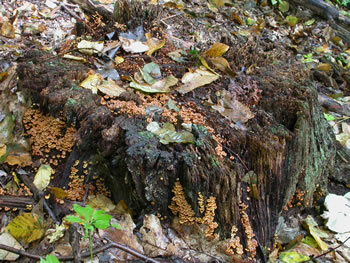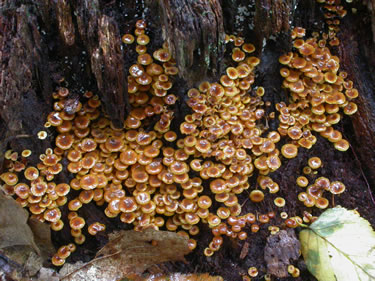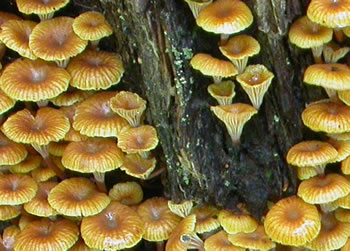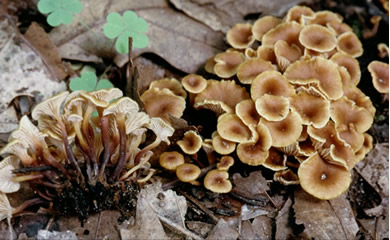Xeromphalina kauffmanii
Scientific name: Xeromphalina kauffmanii A. H. Smith
Derivation of name: Kauffmanii refers to Calvin Henry
Kauffman, who was a professor of Mycology at the
University of Michigan. X. kauffmanii was named in his
honor.
Synonyms: Index Fungorum lists no synonyms.
Common name(s): Cross-veined troop mushroom.
Phylum: Basidiomycota
Order: Agaricales
Family: Mycenaceae
Occurrence on wood substrate: Saprobic; in dense
clusters on decaying hardwood logs and stumps,
especially oak. May through November.
Dimensions: Caps 0.5-2.5 cm wide; stipes 1-4 cm long
and 1-2 mm thick.
Cap:
Brownish-yellow to orange-yellow or yellowish,
darker in the depressed center; smooth; shiny; margin
striate.
Gills: Decurrent; pale yellowish; crossveined.
Spore print: Buff or whitish.
Stipe: Yellowish at apex, reddish-brown toward base;
base covered with tuft of orange or tawny mycelium.
Veil: Absent.
Comments: Xeromphalina campanella is nearly
identical but grows on conifers. In the field, the two
species are difficult to distinguish if the identity of the
wood substrate is unknown. See the X. campanella
page for pictures of crossveined gills and mycelial tufts
at the bases of the stalks, features that are shared with
X. kauffmanii.
More information at MushroomExpert.com
More information at TomVolkFungi.net

Figure 1.
Xeromphalina kauffmanii growing on an oak
stump.
Photo © Gary Emberger.

Figure 2.
One aspect of the common name, troop mushroom,
refers to the manner in which this species often covers the
substrate in great numbers as if by a large army.
Photo © Gary Emberger.

Figure 3. Xeromphalina means "small, dry navel or belly
button" referring to the depressed centers of the small
caps.
Note the decurrent gills and striate caps.
Photo © Gary Emberger.

Figure 4. The stipes are reddish-brown toward the base.
Photo © Steve Nelsen.